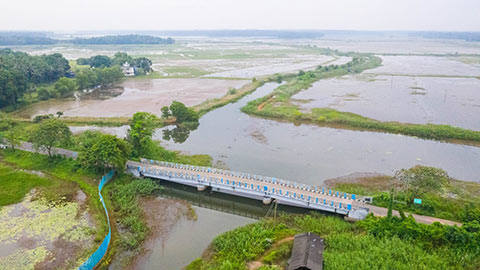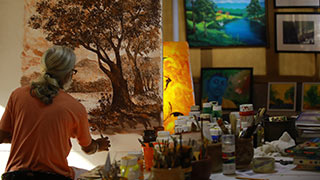 Punnayoorkkulam has a fascinating history that dates back to the late medieval period. According to legends, the last Perumal of the Kulashekara dynasty that ruled the capital of Mahodayapuram, gifted the crown and relics of the ancestral property to his nephew, who was one of the members of the Perumpadappu Swaroopam. The sister of the last Kulasekhara Perumal was married to a Namboothiri from Perumpadappu. So the legend goes such that the Perumpadappu Swaroopam was found by the son born to the Kshatriya-Namboothiri parents. Perumpadappu Swaroopam was a late medieval kingdom and one of the princely states in ancient Kerala. Punnayoorkkulam belongs to Vanneri, which used to be the headquarters of Perumpadappu Swaroopam. Fearing the attacks of the Zamorins of Calicut, the Perumpadappu kings left Vanneri and shifted their headquarters to Thiruvanchikulam and then later to Kochi. As they made Kochi their capital, they were known as the Kings of Kochi and Perumpadappu came to be known as the Kingdom of Cochin.
Punnayoorkkulam has a fascinating history that dates back to the late medieval period. According to legends, the last Perumal of the Kulashekara dynasty that ruled the capital of Mahodayapuram, gifted the crown and relics of the ancestral property to his nephew, who was one of the members of the Perumpadappu Swaroopam. The sister of the last Kulasekhara Perumal was married to a Namboothiri from Perumpadappu. So the legend goes such that the Perumpadappu Swaroopam was found by the son born to the Kshatriya-Namboothiri parents. Perumpadappu Swaroopam was a late medieval kingdom and one of the princely states in ancient Kerala. Punnayoorkkulam belongs to Vanneri, which used to be the headquarters of Perumpadappu Swaroopam. Fearing the attacks of the Zamorins of Calicut, the Perumpadappu kings left Vanneri and shifted their headquarters to Thiruvanchikulam and then later to Kochi. As they made Kochi their capital, they were known as the Kings of Kochi and Perumpadappu came to be known as the Kingdom of Cochin.
A definitive history of Vanneri is not available. The history until the 8th century is based on rumours. Punnayoorkkulam was part of Old Malabar. Today's Punnayurkulam was shaped in 1962. First, it was part of Kozhikode district, then after 1956, the panchayat was part of Palakkad district and after the 1970s, it was brought under Thrissur district.
The road travelled by Tipu Sultan, during his reign, is now known as Tipu Sultan road and runs through the panchayat. The Road and transport system became active in the Panchayath during the 1940s. Before that, those who travelled to Chavakkad took the Conolly Canal and those going to Kunnamkulam chose the waterways until Kattakampal. Similarly, it was in Korothayil Masjid that electricity supply was first introduced during the 1960s. There used to be many famous local physicians in the area. The west side of the Panchayat was densely populated with fishermen. With changing times, the region saw an influx of Gulf money. Such changes have also been reflected in Punnayoorkkulam Panchayat.
National struggles and Punnayoorkkulam
Mahatma Gandhi's wife Kasturba Gandhi had visited Ramaraja U.P. School in Punnayoorkkulam to lent support to the freedom struggle against foreign domination. Braving odds, a lot of women had participated in a summit held at Eliyangattu. During the summit, which was held prior to the temple entry proclamation, the participants signed a resolution. As part of it, the spinning of yarn on charka and handloom weaving was started in Punnayoorkkulam. Activists Sree Narayana Guru, Kelappan and A. K. Gopalan (A.K.G.) visited Punnayoorkkulam at different periods and supported the residents in their protests against untouchability and ban on temple entry.
The presence of these greats helped in making people aware of the domination of the upper caste in the national movement. Acharya Vinoba Bhave too visited Punnayoorkkulam as part of the Bhoodan Movement in 1956. A lot of people donated their land during the meeting at Ramaraja U.P. School. As the Second World War began, workers of the Congress Socialist Party in large numbers joined the Communist party.
The waves of the Khilafat movement that emerged as part of the Freedom struggle was also felt in Punnayoorkkulam village. A lot of people from Punnayoorkkulam had come forward to take part in the National movement.
Along with discrimination, the protests demanding land and freedom surged forward attaining a new dimension. The residents of Punnayoorkkulam participated in numerous farmer protests. In the post-independence period, the mass movements were centred on land struggles. The residents of Punnayoorkkulam too actively participated in these land struggles.

The growth of mass movements along with land reforms changed the face of society. The feudal-landlord system, which was widely prevalent, got completely wiped out. The land reforms act changed the majority of the farmers from tillers to landowners. The lease paid to landlords ceased to exist. After they got land ownership, the farmers started using the skill of negotiation. The change in land ownership patterns uprooted the domination of the upper caste. The struggles for land in Punnayurkulam, where 90% of the land was owned by a few feudal families, ended the suffering of the peasants and tenants. This change in land ownership changed the social life of the residents as well. There were marked changes in the educational, health and social environment.
The panchayat witnessed a visible change in literacy levels as well. The agitation for the surplus land of Karumathazhamana in Punnayoorkkulam panchayath paved the way for many political, social and changes. The Attupuram Chantha (doesn't exist today) in Punnayoorkkulam panchayat was once a witness to many social and political changes. In this Chantha (market), a person named Ayamu was tied to a coconut tree and beaten up for questioning the feudal system. This market had contributed a great deal to the growth of the national movement and the progressive movement.





